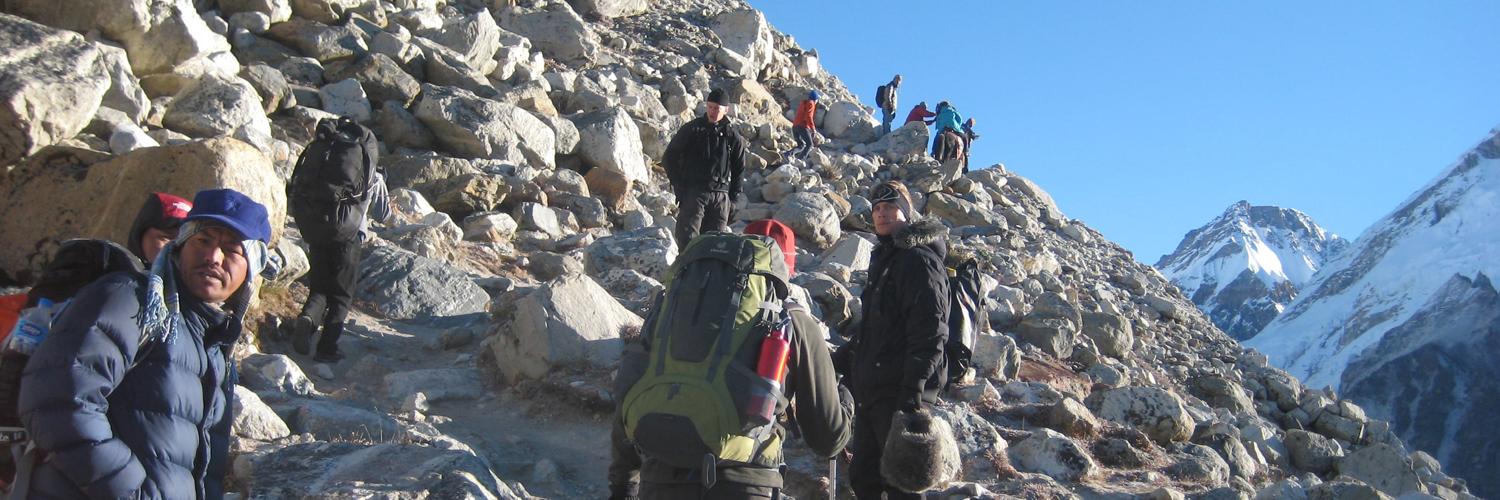1. What is the duration of the Everest Base Camp trek?
The trek typically takes 12 days to complete the start/end of Lukla where you fly from Kathmandu.
2. Is it possible to trek to Everest Base Camp without a guide?
Yes, it is possible to trek independently, but according to the new Nepalese government rule, your trek must be booked through a registered travel agent in Nepal.
3. Are any permits required for the Everest Base Camp trek?
Yes, you will need two permits: a Sagarmatha National Park Permit and a TIMS (Trekkers’ Information Management System) card. There is also another fee involved the Khumbu Municipality entrance fee.
4. What is the best time of year to trek to Everest Base Camp?
The best time is during the pre-monsoon (March to May) and post-monsoon (late September to November) seasons for stable weather and clear views.
5. Do Everest Base Camp Trek have any age restrictions?
There is no specific age restriction and there's a record of five years completing the trek on foot. For individuals over 60, it is advisable to consult with a doctor before undertaking the trek.
6. What is Everest Base Camp elevation?
Everest Base Camp is located at 5,364 meters (17,598 feet) approximately above sea level.
7. Is the Everest Base Camp trek difficult?
The Everest Base Camp trek is not that easy going but not very difficult too. The trek involves walking at high altitudes, and the trail can be steep and rocky in some sections. However, with proper preparation, physical fitness, and acclimatization, it is achievable for most trekkers.
8. Are there tea houses or lodges along the Everest Base Camp trek route?
Yes, the Everest Base Camp trek route is well-developed and lined with tea houses, lodges, and guesthouses. These provide accommodation and meals for trekkers, making it possible to complete the trek without camping gear.
9. What is the maximum altitude reached during the Everest Base Camp trek?
The highest point of the Everest Base Camp trek is Kala Patthar, a viewpoint located at approximately 5,643 meters (18,514 feet) above sea level. This is where trekkers can enjoy breathtaking panoramic views of Mount Everest and the surrounding peaks.
10. How do I get to the starting point of the Everest Base Camp trek?
You need to fly to Lukla from Kathmandu where the trek starts. Alternatively, you fly to Ramechap to Lukla in high trek season since flights from Kathmandu to Lukla don’t operate due to high air traffic.
11. What type of physical fitness is required for the Everest Base Camp trek?
A good level of physical fitness is needed for the trek. Prior hiking or trekking experience is beneficial, but anyone who is in good health, exercises regularly and prepares for the trek can participate. Cardiovascular endurance and strength training are recommended to better cope with the challenging terrain and altitude.
12. Is the Everest base camp trek worth it?
Yes, it is. The Everest Base Camp trek is one of the most renowned treks in the world. The major highlight of the trek is witnessing the world's highest peak, Mt. Everest. The trekking trail passes through spectacular landscapes, Sherpa villages, and diverse cultures of the Khumbu region in Nepal.
13. How much money do I need for the Everest base camp trek?
Our tour package covers accommodation and food during the Everest Base Camp trek. Having additional funds for expenses like hot showers, Wi-Fi, battery charging, and drinks is a practical suggestion. Carrying an additional USD 15 per day should be sufficient to cover these additional expenses. Keep in mind that prices can vary, especially at higher altitudes.
14. How cold is it at Everest base camp?
The trek begins at Lukla, which is already situated at 2,800 meters (9,186 feet) which means you will immediately experience a difference in air temperature. As you ascend further along the trek, you will notice a gradual drop in temperature. Places like Dingboche, located above Namche Bazaar, are at a higher altitude and tend to be colder. The temperature decreases with each gain in elevation, and the nights can become significantly colder than the daytime temperatures
15. How long should you train for the Everest base camp?
Starting physical preparation well in advance is crucial for a successful and enjoyable Everest Base Camp trek or any other trek in Nepal. Making walking the main part of your training routine is an excellent approach, as it helps condition your body for the sustained walking and ascending involved in trekking.
16. Is it dangerous to go to Everest base camp?
Altitude is indeed the primary challenge and potential danger when trekking to Everest Base Camp. The high elevation and reduced oxygen levels can lead to altitude sickness if proper acclimatization is not followed. Taking it slow and allowing for acclimatization days significantly reduces the risk of altitude-related illnesses.
17. Is there WIFI at the Everest base camp?
There is now a Wi-Fi facility available at Everest Base Camp and more than 200 hot spots along the trekking route, thanks to Everest Link company.
18. Is there cell service on Mount Everest?
4G connectivity has been available in the Everest Region since 2010, making it more convenient for trekkers and climbers to stay connected with the outside world. But there are still some remote and less-populated areas, like parts of Gokyo and the Thame Valley, where the service may not be available or may be unreliable.


